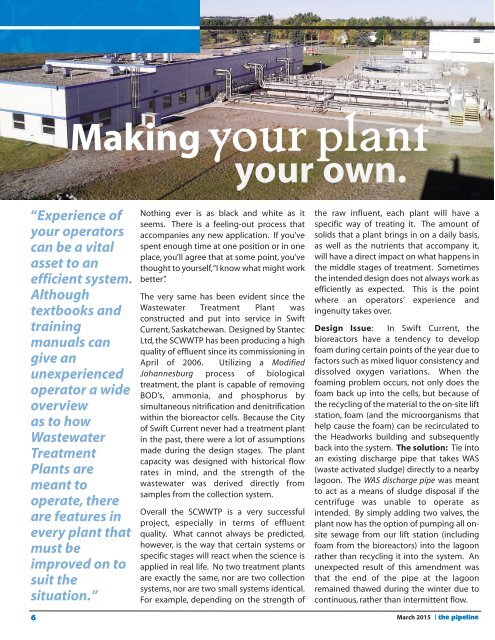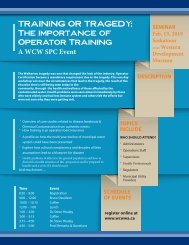2015 March Pipeline
You also want an ePaper? Increase the reach of your titles
YUMPU automatically turns print PDFs into web optimized ePapers that Google loves.
Making your plant<br />
your own.<br />
“Experience of<br />
your operators<br />
can be a vital<br />
asset to an<br />
efficient system.<br />
Although<br />
textbooks and<br />
training<br />
manuals can<br />
give an<br />
unexperienced<br />
operator a wide<br />
overview<br />
as to how<br />
Wastewater<br />
Treatment<br />
Plants are<br />
meant to<br />
operate, there<br />
are features in<br />
every plant that<br />
must be<br />
improved on to<br />
suit the<br />
situation.”<br />
Nothing ever is as black and white as it<br />
seems. There is a feeling-out process that<br />
accompanies any new application. If you’ve<br />
spent enough time at one position or in one<br />
place, you’ll agree that at some point, you’ve<br />
thought to yourself, “I know what might work<br />
better”.<br />
The very same has been evident since the<br />
Wastewater Treatment Plant was<br />
constructed and put into service in Swift<br />
Current, Saskatchewan. Designed by Stantec<br />
Ltd, the SCWWTP has been producing a high<br />
quality of effluent since its commissioning in<br />
April of 2006. Utilizing a Modified<br />
Johannesburg process of biological<br />
treatment, the plant is capable of removing<br />
BOD’s, ammonia, and phosphorus by<br />
simultaneous nitrification and denitrification<br />
within the bioreactor cells. Because the City<br />
of Swift Current never had a treatment plant<br />
in the past, there were a lot of assumptions<br />
made during the design stages. The plant<br />
capacity was designed with historical flow<br />
rates in mind, and the strength of the<br />
wastewater was derived directly from<br />
samples from the collection system.<br />
Overall the SCWWTP is a very successful<br />
project, especially in terms of effluent<br />
quality. What cannot always be predicted,<br />
however, is the way that certain systems or<br />
specific stages will react when the science is<br />
applied in real life. No two treatment plants<br />
are exactly the same, nor are two collection<br />
systems, nor are two small systems identical.<br />
For example, depending on the strength of<br />
the raw influent, each plant will have a<br />
specific way of treating it. The amount of<br />
solids that a plant brings in on a daily basis,<br />
as well as the nutrients that accompany it,<br />
will have a direct impact on what happens in<br />
the middle stages of treatment. Sometimes<br />
the intended design does not always work as<br />
efficiently as expected. This is the point<br />
where an operators’ experience and<br />
ingenuity takes over.<br />
Design Issue: In Swift Current, the<br />
bioreactors have a tendency to develop<br />
foam during certain points of the year due to<br />
factors such as mixed liquor consistency and<br />
dissolved oxygen variations. When the<br />
foaming problem occurs, not only does the<br />
foam back up into the cells, but because of<br />
the recycling of the material to the on-site lift<br />
station, foam (and the microorganisms that<br />
help cause the foam) can be recirculated to<br />
the Headworks building and subsequently<br />
back into the system. The solution: Tie into<br />
an existing discharge pipe that takes WAS<br />
(waste activated sludge) directly to a nearby<br />
lagoon. The WAS discharge pipe was meant<br />
to act as a means of sludge disposal if the<br />
centrifuge was unable to operate as<br />
intended. By simply adding two valves, the<br />
plant now has the option of pumping all onsite<br />
sewage from our lift station (including<br />
foam from the bioreactors) into the lagoon<br />
rather than recycling it into the system. An<br />
unexpected result of this amendment was<br />
that the end of the pipe at the lagoon<br />
remained thawed during the winter due to<br />
continuous, rather than intermittent flow.<br />
Design Issue: Another foam-related problem experienced<br />
at the WWTP was getting the foam to end up at the<br />
intended location. At the end of the bioreactor train, in the<br />
mixed liquor trough, there is a foam removal system. It<br />
consists of a trough that is maintained at a level that allows<br />
a small amount of mixed liquor (ML) to flow into the<br />
trough, carrying any foam build-up with it. The problem<br />
was that sometimes the foam wasn’t being carried away<br />
into the trough with the mixed liquor, but instead floated<br />
on top like a large mat while the ML continued to flow into<br />
the trough. The solution: Create a system that would help<br />
push the mat of foam towards the trough. Operators tried<br />
several versions of water jets that would direct the foam to<br />
its destination. The water spray was effective in the<br />
summer, but tended to freeze in the winter. The idea also<br />
called for a lot of potable water to be used, which in the<br />
long run was not cost effective. Operators contemplated<br />
use of treated effluent to reduce the use of potable water,<br />
but a temporary solution could not be developed due to the<br />
distance from the effluent trench to the ML trough. The staff<br />
finally decided to use an air bubbler process that would<br />
utilize air (from the nearby DO piping) to create a wave of<br />
mixed liquor that would force the mat of foam into the<br />
trough and ultimately away for disposal. It was tested for<br />
12 months using temporary parts & piping to ensure that<br />
the new system would work, and then built permanently<br />
once operators were convinced that all of the bugs had<br />
been worked out. This system is currently still in operation<br />
and maintains the foam level at an absolute minimum<br />
without wasting any potable water.<br />
Design Issue: Waste activated sludge (WAS) that was<br />
pumped to a holding tank until such time as it could be<br />
dewatered was causing problems in the centrifuge.<br />
Because of a good-settling sludge, the WAS in the sludge<br />
tank would settle before it could be dewatered. The sludge<br />
would be very thick at the bottom of the tank, virtually clear<br />
in the middle, and a medium thickness at the top (due to<br />
some sludge floating rather than settling). The plant was<br />
built with a recycle line that was supposed to divert some of<br />
the flow back to the sludge tank, thereby mixing it and<br />
maintaining consistency. The result was an uneven<br />
consistency in the flow to the centrifuge causing highs and<br />
lows, and variable polymer dosing rates. The Solution: A<br />
better mixing method. Staff installed a submersible mixer,<br />
sized according to tank dimensions, and voila, the sludge<br />
was maintained at a consistent thickness, and resulted in<br />
more efficient polymer dose rates and a more consistent<br />
sludge cake. At the same time the mixer was added to the<br />
sludge tank, the Operators also changed the point of<br />
polymer injection from upstream of the RAS pump to<br />
downstream. This reduced the chance of the floc being<br />
sheared while it travelled through the RAS pump impeller.<br />
Although these are just three of a dozen changes<br />
implemented to improve the operations at the SCWWTP,<br />
you can see how experience of your operators can be a vital<br />
asset to an efficient system. Operators in Swift Current have<br />
taken their own ideas, as well as ideas from other plants, and<br />
improved on the original design of the plant. No design is<br />
perfect, we all understand that. Some things cannot be<br />
foreseen, and those things need to work properly for a plant<br />
to function. We encourage our staff to keep thinking up<br />
ways to make our jobs more efficient with as little impact on<br />
the successful operation of the plant itself. Some changes<br />
work wonders, some not at all, some changes are on a much<br />
grander scale, some are so simple that we often ask<br />
ourselves, “Why didn’t we think of that before”. In any case,<br />
your plant will only work for you if you suit it to your needs.<br />
Tim Cox<br />
Superintendent Swift Current Wastewater Treatment Plant.<br />
6<br />
<strong>March</strong> <strong>2015</strong><br />
| the pipeline<br />
the pipeline | <strong>March</strong> <strong>2015</strong> 7

















